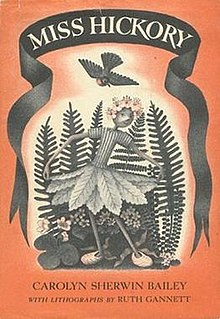Module 4: Newbery Winners
Miss Hickory by Carolyn Sherwin Bailey
Illustrated with Lithographs by Ruth Gannett
Illustrated with Lithographs by Ruth Gannett

Bailey, C. (1946). Miss Hickory. New York, NY: Viking Penguin.
Plot Summary:
The story follows an apple twig doll with a hickory nut head, Miss Hickory, though the trials of surviving a winter in the woods, when her human family leaves for Boston. Her corncob house cannot withstand the harsh winter that is to come, so she must move to a Robin's nest in an apple tree which Crow has helped her find. During the winter, she meets new friends and engages in new adventures. She helps Hen-Pheasant form a Ladies' Aid society for the female pheasants who have been pushed away by their cocks and teaches her to quilt. Miss Hickory also meets Squirrel who she she has a series of uncomfortable situations with. She goes to the Christmas celebration at the Barn and sees a variety of animals, but misses the manager because she arrived late.
When spring finally arrives, she encounters housing troubles again when birds have moved into her nest and laid eggs. After an aggressive encounter over the nest ownership, she walks alone in her ruined spring clothes and eventually finds herself in Squirrel's hole. An argument between Squirrel and Miss Hickory breaks out and he eats her head. A headless Miss Hickory flees and runs back to the apple tree. She climbs up the branches towards the sun. Suddenly she is overwhelmed with energy and life. She has become a scion, which reinvigorates the tree and it begins to bloom, and starts a new life as part of the apple tree.
Impressions:
While this story is quaint and has an appealing country vibe, I found the story to be excessively long. The tales of the various animals preparing for and surviving winter are interesting, but drawn out. Miss Hickory is not a particularly friendly character, so I am not emotionally attached to her. I am just following her winter story. Finally, the ending is the most unsettling portion of the book. The Squirrel straight up eats her head. It is a shocking and off putting turn of event. But somehow it turns out okay because she becomes part of a tree? It doesn't really work in my opinion, but it turns a tragic end for Miss Hickory into a new beginning.
Reviews:
Reviews:
Miss Hickory by Carolyn Sherwin Bailey | Kirkus Reviews. (n.d.). Retrieved from https://www.kirkusreviews.com/book-reviews/carolyn-sherwin-bailey-4/miss-hickory/
"Frankly, we found it long-winded and dull adventures with an air of preciousness throughout. The author is better at recreating old customs than in telling an original story.
Gillespie, J. T., & Naden, C. J. (2001). Newbery Winner 1947. The Newbery Companion: Booktalk and Related Materials for Newbery Medal and Honor Books (pg.143). Greenwood Village, Colorado: Libraries Unlimited.
"This is a delightful fantasy that enters the country of a child's imagination and preserves the rhapsodies of childhood. It depicts the charm of a New Hampshire winter from an angle that humans never know."
Library Use Suggestions:
Miss Hickory would make a good edition to a display on illustration. The lithograph illustrations by Ruth Gannett are a great example of a different style of artwork in books.
Additionally, Miss Hickory could be used as a way to demonstrate changes in seasons for older children. The stories of the different animals give the reader a view of how the different animals act during winter and how their prepare. I would suggest excerpts rather than the whole book. It is not a perfect representation of nature (it is fiction after all), but it could lead into further discussion.
Additionally, Miss Hickory could be used as a way to demonstrate changes in seasons for older children. The stories of the different animals give the reader a view of how the different animals act during winter and how their prepare. I would suggest excerpts rather than the whole book. It is not a perfect representation of nature (it is fiction after all), but it could lead into further discussion.
No comments:
Post a Comment